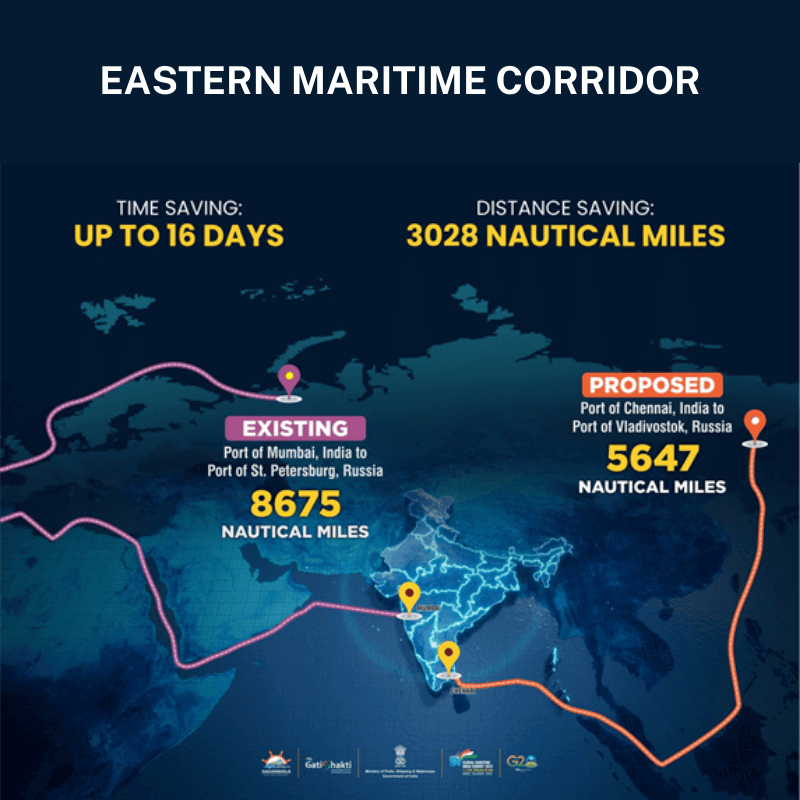
The Chennai-Vladivostok Maritime Corridor (CVMC) is a shipping route aimed at enhancing connectivity between Chennai, India, and Vladivostok, Russia. This initiative is part of broader efforts to strengthen economic and strategic ties between India and Russia, particularly in the Indo-Pacific region. Read here to learn more.
India and Russia have officially operationalised the Chennai-Vladivostok Eastern Maritime Corridor (CVMC), also known as the Eastern Maritime Corridor a pivotal sea route designed to strengthen bilateral trade and connectivity.
The Minister of Minister of Ports, Shipping, and Waterways announced the same at the inaugural edition of the ‘Sagarmanthan: The Great Oceans Dialogue’ summit organised by the Ministry in partnership with the Observer Research Foundation.
India and Greece would work together on the India-Middle East-Europe Economic Corridor (IMEEC) announced in 2023.
India aims to be the best maritime nation in the world in all indices, in keeping with the ‘maritime vision 2047’.
Chennai-Vladivostok Maritime Corridor

The corridor, first conceptualised in September 2019 following an agreement between Indian Prime Minister Narendra Modi and Russian President Vladimir Putin, spans approximately 10,300 kilometres.
This route links Chennai with Vladivostok while connecting major Indian ports such as Paradip and Visakhapatnam.
By reducing transit times by 40 per cent, the corridor promises to revolutionise trade logistics for both nations.
Key commodities, including crude oil, liquefied natural gas, fertilisers, machine parts, and textiles, have already started flowing through the corridor. This operationalisation aligns with India’s Act East Policy.
Experts believe that as the corridor gains momentum, its impact on India-Russia trade relations and regional logistics will be closely monitored, highlighting its strategic role in fostering economic integration and resilience in global supply chains.
Strategic Importance of Chennai-Vladivostok Maritime Corridor
It will connect India’s eastern coast with Russia’s Far East, a resource-rich region, enhancing bilateral trade.
The corridor aligns with India’s “Act East policy” and Russia’s “Pivot to the East” strategy, boosting collaboration in the Indo-Pacific.
Trade and Economic Benefits:
- Reduces shipping time between India and Russia to about 24-26 days, compared to the longer traditional routes through Europe or the Suez Canal.
- Facilitates the export of oil, gas, and minerals from Russia’s Far East to India and imports of Indian pharmaceuticals, machinery, and agricultural products into Russia.
Geopolitical Implications:
- Provides an alternative to traditional maritime routes dominated by other powers.
- Strengthens Russia-India relations amid evolving global dynamics.
Infrastructure Development:
- Includes development of port infrastructure and supporting facilities in both regions.
- Part of broader connectivity initiatives such as the International North-South Transport Corridor (INSTC).
Challenges
- High infrastructure costs, including port and logistics development.
- Navigational issues in the Arctic region due to harsh weather conditions.
- Potential geopolitical tensions affecting trade routes.
Significance for India
The Chennai-Vladivostok Maritime Corridor (CVMC) is a proposed shipping route between Chennai, India, and Vladivostok, Russia. It holds significant geopolitical and economic importance for India, particularly in countering Chinese dominance in the Indo-Pacific and Eurasian regions.
Strategic Diversification of Energy Supplies:
- Russia’s Far East is rich in energy resources like oil, gas, and coal. The corridor can facilitate energy imports, reducing India’s overdependence on the Middle East and diversifying energy sources.
- This aligns with India’s goal of energy security, especially in light of increasing geopolitical tensions in West Asia.
Enhanced Connectivity with Russia’s Far East:
- By strengthening ties with Vladivostok, India gains access to the Arctic region and Russia’s mineral-rich Far East, which includes strategic commodities like gold, diamonds, and rare earth metals.
- The corridor complements India’s investments in the Far East under the India-Russia partnership.
Economic Opportunities:
- The CVMC can reduce shipping times between India and Russia by over 40%, enhancing trade efficiency.
- It provides a cost-effective alternative to land routes through Central Asia and mitigates risks associated with the Suez Canal.
Boosting Act Far East Policy:
- This corridor reinforces India’s “Act Far East” policy, mirroring its Act East Policy aimed at Southeast Asia. It enhances India’s regional influence in the Pacific and supports Russia’s development plans in the Far East.
Countering Chinese Dominance
- Alternative Supply Chain Routes: The CVMC bypasses Chinese-controlled trade routes like the South China Sea, offering India and its partners more secure and independent shipping lanes.
- Balancing the Belt and Road Initiative (BRI):
- India’s active participation in CVMC creates a counter-narrative to China’s BRI by promoting a multilateral and balanced trade route.
- It encourages cooperation with Russia, potentially bringing ASEAN and QUAD members into collaborative trade projects.
- Maritime Security: The corridor provides India leverage in the Indo-Pacific region, crucial for maintaining free and open sea lanes. This counters China’s growing military assertiveness in these waters.
- Strengthening Indo-Russian Strategic Ties: By aligning with Russia’s pivot to Asia, India can challenge China’s monopolistic influence over the Eurasian economic space. Strengthening ties with Russia offers a strategic edge in geopolitical alignments.
Conclusion
This corridor, if implemented effectively, could serve as a vital link connecting two pivotal regions, fostering economic growth and regional stability.
The tensions in West Asia have disrupted global shipping which revived interest in the Chennai-Vladivostok Eastern Maritime Corridor.
Better freight and passenger connectivity between Southern India and Russia’s Far East will open new areas for bilateral cooperation such as the export of machinery, auto parts and engineering goods from India, and progressively integrate the economies of the two countries.
Frequently Asked Questions (FAQs)
Q. How far is Vladivostok from Chennai by sea route?
Ans: The Chennai-Vladivostok Sea route will cover a distance of about 5,600 nautical miles or 10,500 km. The Eastern Maritime Corridor between Vladivostok and Chennai is operational now.
Q. What is the current sea route to Russia from India?
Ans: Currently, the route from Mumbai to St. Petersburg, Russia, via the Western Sea Route and Suez Canal spans 8,675 nautical miles or 16,066 km. A large container ship from India takes around 40 days to reach Russia’s Far East region through Europe.
Related articles:
-Article by Swathi Satish






Leave a Reply